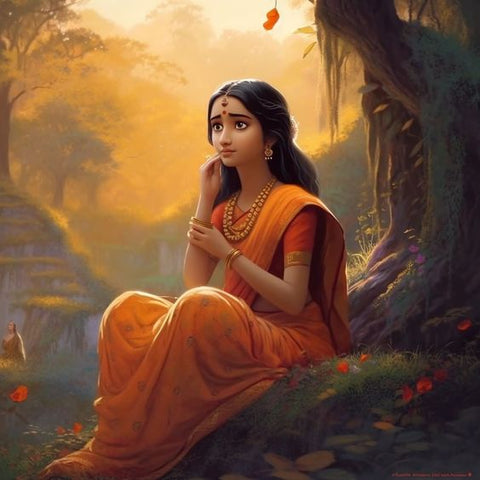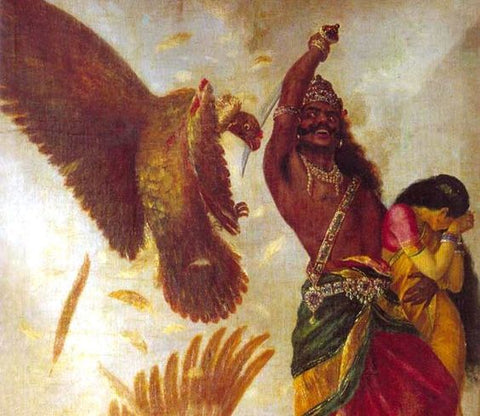As a kid growing up, Ramayana was presented to us as one of the golden novels. The great epic Ramayana held with it a grandeur even in its name.
Told by generations of parents and grandparents to their kids, no household is complete without having the novel in its bookshelves.
And in my case, I had three, from the animated version to the unabridged one.
And without fail, each of them begins with King Dasharatha and the story of how Lord Rama was born, thanks to a blessed fruit, split amongst his wives, that birthed Lord Rama, alongside his brothers.
However, little is said about Sita, and her origins, though the thundering end to this epic includes the ground caving in on itself as Bhoomadevi takes back her daughter from her sacrificial fire.
The enigmatic origins of Sita, however, have long intrigued scholars and storytellers alike.
While the widely accepted belief is that King Janaka of Mithila was her father, a lingering mystery persists, does it not?
In the heart of this ancient narrative, an alternative theory whispers softly, suggesting that Ravana, the formidable demon king of Lanka, might be the true father of Sita.
The human spirit, ever curious, has woven countless threads of speculation around her family tree. Can you blame us?
Ramayana is a tale as old as time, and to not be sure of such a fundamental fact shakes the very foundation of the story that has been revered across generations.
So, this article is going to be our brief exploration into looking at the true patronage of Sita Mata.
The Story of Sita's Discovery

The tale of Sita's discovery weaves an important part in unveiling this mystery.
Mentioned vaguely in the take of Ramayana, the story goes, King Janaka, the noble ruler of Mithila, stumbled upon a divine secret while ploughing the earth for a yajna (sacred ritual).
Cradled within the furrows, he unearthed an infant, whom he named “Sita” and decided to raise her as his own daughter.
Janaka's relationship with Sita also hints at a deeper mystery. Some scholars propose that this story signifies adoption rather than biological paternity.
King Janaka, known for his unwavering righteousness, embraced Sita as his own, raising her with love and care.
This story shows that being a parent isn't just about blood. It's about love and care. Janaka's deep connection with Sita teaches us that family bonds can go beyond biology.
It reminds us that real parenthood is defined by the love we share, not just by genes.
The Case for Ravana as Sita's Father
Ramayana is typically even mentioned as Valmiki's Ramayana, recounting Lord Rama's heroic journey and Sita's abduction by the demon king Ravana. This is the one most commonly known.
However, the story of Ramayana has variations. The Gond Ramayani, revered by the Gond tribal community, curiously omits Ravana, offering a unique perspective.
Now, the question arises, Could Ravana be Sita's biological father? In the Jain version by Sanghadasa, the narrative takes yet another different path.
It doesn't start with King Janaka and Queen Sunaina discovering Sita but begins with Vedavati, who captivates Ravana. She avoids Ravana's evil intentions and, upon self-immolation, curses him.
In her next life, Ravana and his queen are blessed with a daughter named Vasudevahindi, believed to be Vedavati's reincarnation.
Fearful of the curse, Ravana casts the child into the ocean, where she's miraculously saved by the goddess Varuni and entrusted to Bhumadevi.
Valmiki's Ramayana, however, remains vague about Sita's parentage. In Valmiki's version, her origin isn't explicitly mentioned.

In yet another version, the Uttar Purana by Manivati presents a unique twist. Here, it is Manivati, not Vedavati, who becomes the reason for Ravana's downfall.
Manivati falls prey to Ravana's intentions, and in her next birth, she is born as Ravana and Mandodari's daughter. Ravana, aware of the curse, orders the baby girl's death.
Instead, she is buried near Mithila by Ravana's servant, sparking questions about how King Janaka found her.
The question of which daughter truly brought about Ravana's demise remains a matter of debate. Some uphold Vedavati's version, while others favor Manivati's role.
These various interpretations continue to raise questions about the narrative of the Ramayana, adding layers of complexity and intrigue to this timeless epic.
Critical Evaluation of the Ravana Theory
The notion of Ravana being the father of Sita, as intriguing as it may be, is not without its share of skepticism and counter-arguments.
It seems unthinkable that the main antagonist in a tale as old as time, where Ravana with his evil disguise and cruel abduction could have ever fathered Sita mata.
While some versions and interpretations suggest this alternative paternity, there are critical aspects that seemingly contradict this theory.
One of the primary counter-arguments lies in the foundational text of Valmiki's Ramayana. The well-known version which does not explicitly mention Sita's biological parentage, leaving room for interpretation.
However, this ambiguity doesn't necessarily mean the theory of Ravana as her father. It, however, does allow the question to be open, thus, inviting various interpretations.

The traditional narrative of King Janaka discovering Sita while ploughing a field is usually the known one. This narrative is deeply embedded in cultural and religious traditions.
It is further reinforced by Valmiki's Ramayana, making it a compelling argument against Ravana's paternity.
Moreover, the historical and cultural significance of the Ramayana across diverse regions and belief systems further expands the skepticism surrounding the Ravana theory.
The Rama-Sita narrative is not just a story, it's a cornerstone of moral and ethical teachings, devotion, and cultural identity for millions.
The idea of Ravana being Sita's father stirs debate because it goes against the well-known story.
It makes us rethink the characters in the epic and challenges what we believe to be true. It also makes us question the usual way we see heroes and villains in the story.
This debate shows how the Ramayana continues to be fascinating and thought-provoking, even after all these years.
The traditional story is deeply ingrained in our culture, making it hard for some to accept this new perspective. They prefer to stick with what they know.
So, while the Ravana theory is intriguing, it faces strong skepticism mainly because most people believe in the traditional tale, and the ancient texts don't directly confirm this alternative idea.
Brass Ram Symbol Diya (5 Inch)
Conclusion
The question of who fathered Sita remains an enigma, with various theories and perspectives vying for attention.
The possibility of Ravana as Sita's father has emerged as a thought-provoking alternative, challenging the widely accepted narrative of King Janaka's paternity.
Yet, amidst these diverse interpretations, a firm belief remains elusive, and the mystery endures.
The traditional account of Sita's discovery by King Janaka while ploughing a field holds sway in the hearts and minds of many, steeped in cultural and religious traditions.
The ambiguity surrounding Sita's parentage in Valmiki's Ramayana does nothing but add to the complexity.
Skepticism regarding Ravana's paternity stems from the deeply ingrained belief in the conventional narrative and the absence of explicit textual evidence.
The idea of Ravana as Sita's father challenges our understanding of the characters and the epic's moral dynamics, contributing to the ongoing debate.
The question of Sita's true parentage in the Ramayana is a testament to the timeless allure of this epic. The absence of a definitive answer invites continued exploration and contemplation.
The deeper we look, the more evident it is that more research is needed to shed light on this intriguing and eternal question.








